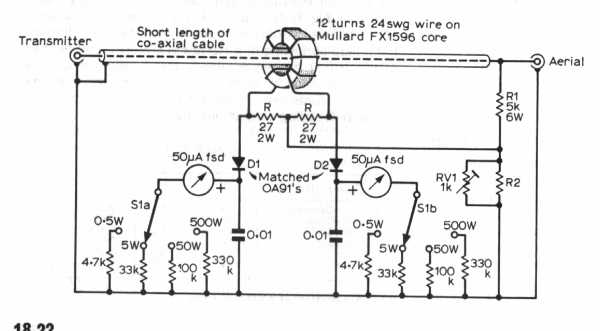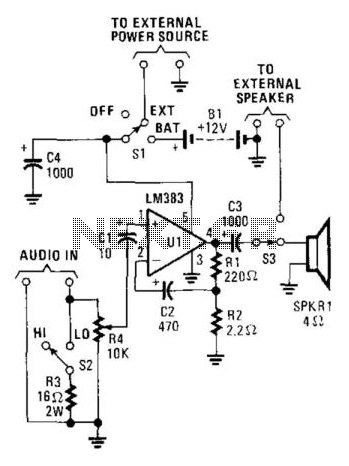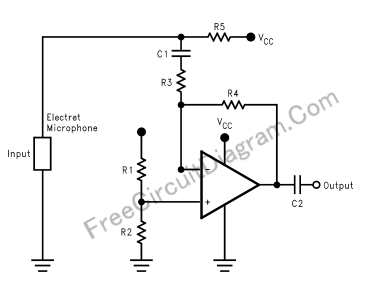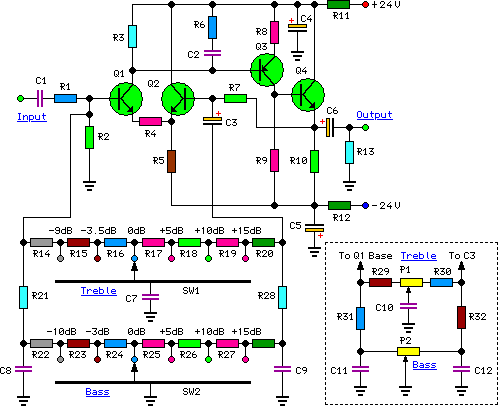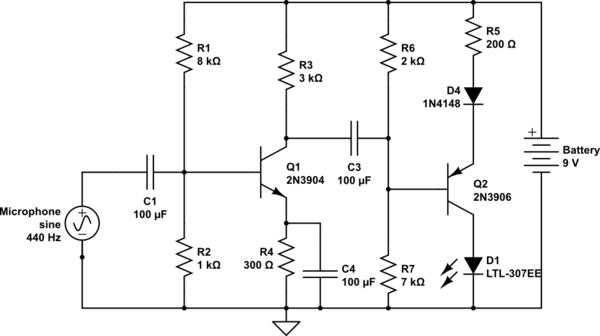
UHF Wideband TV Amplifier for Signal

This UHF wideband signal amplifier provides a total gain of 10 to 15 dB within the 400 - 850 MHz frequency range, making it suitable for applications where the television signal is weak. For optimal performance, the component pins must be kept as short as possible. Capacitors C1, C2, C6, and C7 are of the SMD (surface-mounted device) type. The UHF TV signal amplifier should be housed within a metal enclosure and positioned close to the TV antenna. The power supply required is a simple stabilized 12V source. The amplifier can be connected directly to the power supply via a coaxial cable from the TV antenna, but it requires a 10 - 100 µH inductor on the power line. The television set is connected to the UHF amplifier through a small coupling capacitor. Adjustment is straightforward; set potentiometer P1 to the midpoint and then fine-tune it to achieve the best quality of the television image.
The UHF wideband signal amplifier is designed to enhance weak television signals, particularly in the UHF frequency range of 400 to 850 MHz. The amplifier's gain, specified between 10 and 15 dB, is critical for improving signal strength, which is especially beneficial in areas with poor reception.
The construction of the amplifier involves careful attention to the physical layout of the components. Surface-mounted devices (SMDs) such as capacitors C1, C2, C6, and C7 should be mounted with minimal lead length to reduce parasitic inductance and capacitance, which can adversely affect performance. The metal enclosure not only protects the circuitry but also serves to shield the amplifier from electromagnetic interference (EMI), enhancing overall signal integrity.
Powering the amplifier requires a stabilized 12V source, which ensures consistent operation. The use of a coaxial cable for the connection from the antenna to the amplifier is standard practice, as it minimizes signal loss and provides a robust connection. The introduction of a 10 - 100 µH inductor in the power line is essential for filtering out noise from the power supply, thereby improving the amplifier's performance.
The coupling capacitor serves to isolate the amplifier from the television set while allowing the amplified signal to pass through. This design choice prevents any DC voltage present in the amplifier from affecting the TV circuitry.
Adjustment of the amplifier is simplified with the inclusion of potentiometer P1. Setting P1 to the midpoint allows for a baseline configuration, from which fine-tuning can be performed to optimize the image quality. This user-friendly adjustment mechanism is crucial for achieving the best possible performance in varying signal conditions, ensuring that users can easily adapt the amplifier to their specific environment.
In summary, the UHF wideband signal amplifier is a vital component for enhancing weak television signals, and its design incorporates several key features that ensure optimal performance and ease of use.This UHF wideband signal amplifier has a total gain of 10 to 15 dB in the 400 - 850 MHz domain frequency so it can be used where the tv signal is weak. For UHF TV signal amplifier to work correctly, you need to cut the components pins as short as possible.
C1, C2, C6, C7 are SMD type (surface mounted). This antenna tv amplifier or uhf wideband amp lifier need to be build inside of a metal box and then connected close to the tv antenna. The power supply is a simple 12V stabilized source. The tv antenna amplifier can be connected directly to the power supply thru coaxial cable of the tv antenna but you need a 10 - 100uH coil on the alimentation line. The tv set will be connected to the uhf amplifier thru a small coupling capacitor. Adjusting is easy, just bring the P1 to the middle and then adjust it untill you obtain the best tv image quality.
🔗 External reference
The UHF wideband signal amplifier is designed to enhance weak television signals, particularly in the UHF frequency range of 400 to 850 MHz. The amplifier's gain, specified between 10 and 15 dB, is critical for improving signal strength, which is especially beneficial in areas with poor reception.
The construction of the amplifier involves careful attention to the physical layout of the components. Surface-mounted devices (SMDs) such as capacitors C1, C2, C6, and C7 should be mounted with minimal lead length to reduce parasitic inductance and capacitance, which can adversely affect performance. The metal enclosure not only protects the circuitry but also serves to shield the amplifier from electromagnetic interference (EMI), enhancing overall signal integrity.
Powering the amplifier requires a stabilized 12V source, which ensures consistent operation. The use of a coaxial cable for the connection from the antenna to the amplifier is standard practice, as it minimizes signal loss and provides a robust connection. The introduction of a 10 - 100 µH inductor in the power line is essential for filtering out noise from the power supply, thereby improving the amplifier's performance.
The coupling capacitor serves to isolate the amplifier from the television set while allowing the amplified signal to pass through. This design choice prevents any DC voltage present in the amplifier from affecting the TV circuitry.
Adjustment of the amplifier is simplified with the inclusion of potentiometer P1. Setting P1 to the midpoint allows for a baseline configuration, from which fine-tuning can be performed to optimize the image quality. This user-friendly adjustment mechanism is crucial for achieving the best possible performance in varying signal conditions, ensuring that users can easily adapt the amplifier to their specific environment.
In summary, the UHF wideband signal amplifier is a vital component for enhancing weak television signals, and its design incorporates several key features that ensure optimal performance and ease of use.This UHF wideband signal amplifier has a total gain of 10 to 15 dB in the 400 - 850 MHz domain frequency so it can be used where the tv signal is weak. For UHF TV signal amplifier to work correctly, you need to cut the components pins as short as possible.
C1, C2, C6, C7 are SMD type (surface mounted). This antenna tv amplifier or uhf wideband amp lifier need to be build inside of a metal box and then connected close to the tv antenna. The power supply is a simple 12V stabilized source. The tv antenna amplifier can be connected directly to the power supply thru coaxial cable of the tv antenna but you need a 10 - 100uH coil on the alimentation line. The tv set will be connected to the uhf amplifier thru a small coupling capacitor. Adjusting is easy, just bring the P1 to the middle and then adjust it untill you obtain the best tv image quality.
🔗 External reference
Warning: include(partials/cookie-banner.php): Failed to open stream: Permission denied in /var/www/html/nextgr/view-circuit.php on line 713
Warning: include(): Failed opening 'partials/cookie-banner.php' for inclusion (include_path='.:/usr/share/php') in /var/www/html/nextgr/view-circuit.php on line 713
